Cooperative Lane-Change Control Method for Freeways Considering Dynamic Intelligent Connected Dedicated Lanes
Abstract
:1. Introduction
2. Methodology
2.1. Scene and Problem Description
- (1)
- All CAVs are capable of obtaining operational information about surrounding vehicles and receiving control commands from RSUs through vehicle-to-vehicle, vehicle-to-infrastructure, and vehicle-to-cloud communications, and they fully comply with these control instructions. HDVs strictly adhere to a car-following model control.
- (2)
- Communication delays are not considered; all information is exchanged in real-time.
- (1)
- CAV autonomous cooperative lane change
- (2)
- HDV mandatory cooperative lane change
2.2. Decision-Making Framework for Lane Changing
- (1)
- CAV Autonomous Cooperative Lane-Change Decision Framework
- (2)
- HDV Mandatory Cooperative Lane-Change Decision Framework
3. Construction of Lane-Changing Models
3.1. Lane-Changing Safety Gap
3.2. Lane-Changing Model
3.2.1. Autonomous Cooperative Lane-Changing Control Model
3.2.2. Mandatory Cooperative Lane-Changing Control Model
- Scenario ①: in the target lane, the leading vehicle is an HDV, followed by a CAV
- Scenario ②: in the target lane, the leading vehicle is a CAV, followed by an HDV
3.3. Optimization Algorithm
4. Simulation Experiment
4.1. Simulation Parameter Settings
4.2. Simulation Scenario
- (1)
- Autonomous Cooperative Lane-Changing Simulation Scenario for CAVs
- (2)
- Mandatory Cooperative Lane-Changing Simulation Scenario for HDV
4.3. Discussion of Results
- (1)
- Simulation results for CAV autonomous cooperative lane change
- (a)
- Lane-change Success Rate
- (b)
- The impact on vehicles participating in cooperative lane changing
- (2)
- Simulation results for HDV mandatory cooperative lane change
5. Conclusions
- (1)
- In scenarios of CAV autonomous cooperative lane change, compared with traditional lane-changing models, the autonomous cooperative lane-change model exhibits superior performance in enhancing the success rate of lane changes, reducing lane-changing time, diminishing the impact on the speed of surrounding vehicles, and more quickly restoring a stable driving state.
- (2)
- In scenarios of HDV mandatory cooperative lane change, compared with traditional lane-changing models, the mandatory cooperative lane-change model demonstrates better control efficiency in reducing vehicle travel time, increasing vehicle speed, increasing the number of vehicles passing through the road, and improving the success rate of lane changes.
- (3)
- The results from the study of CAV autonomous cooperative lane change and HDV mandatory cooperative lane change suggest that under the management strategy of DIC dedicated lanes, by facilitating multi-vehicle collaborative lane changes, the efficiency of lane changing can be improved and the stop-and-go waves caused by lane changing in traffic flow can be reduced. Providing dedicated lanes for CAVs can significantly enhance road traffic efficiency while avoiding the waste of road resources.
Author Contributions
Funding
Informed Consent Statement
Data Availability Statement
Conflicts of Interest
References
- Ma, C.; Li, D. A review of vehicle lane-change research. Phys. A Stat. Mech. Its Appl. 2023, 18, 129060. [Google Scholar] [CrossRef]
- Yang, D.; Lv, M.; Dai, L.Y.; Wang, X.W.; Guo, X. Lane Selection Decision Model for Autonomous Vehicles in the Connected Vehicle Environment. China J. Highw. Transp. 2022, 35, 243–255. [Google Scholar] [CrossRef]
- Gipps, P.G. A model for the structure of lane-changing decisions. Transp. Res. Part B Methodol. 1986, 20, 403–414. [Google Scholar] [CrossRef]
- Yang, Q.I.; Koutsopoulos, H.N. A microscopic traffic simulator for evaluation of dynamic traffic management systems. Transp. Res. Part C Emerg. Technol. 1996, 4, 113–129. [Google Scholar] [CrossRef]
- Halati, A.; Lieu, H.; Walker, S. CORSIM-Corridor Traffic Simulation Model. Traffic Congestion and Traffic Safety in the 21st Century: Challenges, Innovations, and Opportunities Urban Transportation Division, ASCE; Highway Division, ASCE; Federal Highway Administration, USDOT; and National Highway Traffic Safety Administration, USDOT. 1997. Available online: http://worldcat.org/isbn/0784402434 (accessed on 21 March 2024).
- Yang, M.; Wang, X.; Quddus, M. Examining lane-change gap acceptance, duration and impact using naturalistic driving data. Transp. Res. Part C Emerg. Technol. 2019, 104, 317–331. [Google Scholar] [CrossRef]
- Liu, Y.; Zhou, B.; Wang, X.; Li, L.; Cheng, S.; Chen, Z.; Li, G.; Zhang, L. Dynamic lane-changing trajectory planning for autonomous vehicles based on discrete global trajectory. IEEE Trans. Intell. Transp. Syst. 2021, 23, 8513–8527. [Google Scholar] [CrossRef]
- Kesting, A.; Treiber, M.; Helbing, D. General lane-changing model MOBIL for car-following models. Transp. Res. Rec. 2007, 1999, 86–94. [Google Scholar] [CrossRef]
- Yang, J.S.; Wang, P.W.; Gao, S.; Zhang, M.; Wei, X.P.; Zhang, Y.L. Research on Support Vector Machine-Based Vehicle Lane-change Decision Model. J. Shandong Univ. Technol. (Nat. Sci. Ed.) 2023, 37, 66–72. [Google Scholar] [CrossRef]
- Zhao, S.E.; Ke, T.; Liu, P. Research on Vehicle Lane-change Decision Model Based on Bayesian Networks. J. Chongqing Jiaotong Univ. (Nat. Sci.) 2020, 39, 130–137+144. [Google Scholar] [CrossRef]
- Kamrani, M.; Srinivasan, A.R.; Chakraborty, S.; Khattak, A.J. Applying Markov decision process to understand driving decisions using basic safety messages data. Transp. Res. Part C Emerg. Technol. 2020, 115, 102642. [Google Scholar] [CrossRef]
- Zhao, J.D.; Zhao, Z.M.; Qu, Y.C.; Xie, D.F.; Sun, H.J. Research on Trajectory Data-Driven Vehicle Lane-change Intent Recognition. J. Transp. Syst. Eng. Inf. Technol. 2022, 22, 63–71. [Google Scholar] [CrossRef]
- Shi, Q.; Zhang, H. An improved learning-based LSTM approach for lane-change intention prediction subject to imbalanced data. Transp. Res. Part C Emerg. Technol. 2021, 133, 103414. [Google Scholar] [CrossRef]
- Zhang, H.; Du, L.; Shen, J. Hybrid MPC system for platoon based cooperative lane-change control using machine learning aided distributed optimization. Transp. Res. Part B Methodol. 2022, 159, 104–142. [Google Scholar] [CrossRef]
- Kawabata, K.; Ma, L.; Xue, J.; Zhu, C.; Zheng, N. A path generation for automated vehicle based on Bezier curve and via-points. Robot. Auton. Syst. 2015, 74, 243–252. [Google Scholar] [CrossRef]
- Xie, D.F.; Fang, Z.Z.; Jia, B.; He, Z. A data-driven lane-changing model based on deep learning. Transp. Res. Part C Emerg. Technol. 2019, 106, 41–60. [Google Scholar] [CrossRef]
- Yu, Y.; Luo, X.; Su, Q.; Peng, W. A dynamic lane-changing decision and trajectory planning model of autonomous vehicles under mixed autonomous vehicle and human-driven vehicle environment. Phys. A Stat. Mech. Its Appl. 2023, 609, 128361. [Google Scholar] [CrossRef]
- Fu, M.; Li, S.; Guo, M.; Yang, Z.; Sun, Y.; Qiu, C.; Wang, X.; Li, X. Cooperative decision-making of multiple autonomous vehicles in a connected mixed traffic environment: A coalition game-based model. Transp. Res. Part C Emerg. Technol. 2023, 157, 104415. [Google Scholar] [CrossRef]
- Ji, A.; Ramezani, M.; Levinson, D. Pricing lane-changes. Transp. Res. Part C Emerg. Technol. 2023, 149, 104062. [Google Scholar] [CrossRef]
- Monteiro, F.V.; Ioannou, P. Safe autonomous lane-changes and impact on traffic flow in a connected vehicle environment. Transp. Res. Part C Emerg. Technol. 2023, 151, 104138. [Google Scholar] [CrossRef]
- Liu, Y.; Wang, H.; Dong, C.; Chen, Y. A centralized relaxation strategy for cooperative lane-change in a connected environment. Phys. A Stat. Mech. Its Appl. 2023, 624, 128934. [Google Scholar] [CrossRef]
- Wang, Z.; Mi, Q.; Xiang, J.; Zhang, Z.L.; Tang, J.J. An evaluation of lane management strategy for CAV priority in mixed traffic. IET Intell. Transp. Syst. 2024, 18, 467–479. [Google Scholar] [CrossRef]
- Sha, H.; Singh, M.K.; Haouari, R.; Papazikou, E. Network-wide safety impacts of dedicated lanes for connected and autonomous vehicles. Accid. Anal. Prev. 2024, 195, 107424. [Google Scholar] [CrossRef] [PubMed]
- Wu, W.; Head, L.; Yan, S.; Ma, W. Development and evaluation of bus lanes with intermittent and dynamic priority in connected vehicle environment. J. Intell. Transp. Syst. 2018, 22, 301–310. [Google Scholar] [CrossRef]
- Li, P.F.; Shi, J.J.; Liu, X.M. Analysis of Competitive and Cooperative Lane Changing Behavior Characteristics on Urban Expressways. J. Highw. Transp. Dev. 2016, 33, 130–139. [Google Scholar]
- Ma, J.; Li, X.; Zhou, F.; Hu, J.; Park, B.B. Parsimonious shooting heuristic for trajectory design of connected automated traffic part II: Computational issues and optimization. Transp. Res. Part B Methodol. 2017, 95, 421–441. [Google Scholar] [CrossRef]
- Zhan, H.; Wang, G.; Shan, X.; Liu, Y. Risk-aware lane-change trajectory planning with rollover prevention for autonomous light trucks on curved roads. Mech. Syst. Signal Process. 2024, 211, 111126. [Google Scholar] [CrossRef]
- Cui, J.F.; Hu, B.X.; Xia, H.; Chen, H.; Chen, X.G. Simulation and Comparative Analysis of Multiple Vehicle Platoon Models in the SUMO Platform. J. Chongqing Univ. 2021, 44, 43–54+98. [Google Scholar] [CrossRef]
- Milanés, V.; Shladover, S.E. Modeling cooperative and autonomous adaptive cruise control dynamic responses using experimental data. Transp. Res. Part C Emerg. Technol. 2014, 48, 285–300. [Google Scholar] [CrossRef]
- Xiao, L.; Wang, M.; Arem, B.V. Realistic Car-Following Models for Microscopic Simulation of Adaptive and Cooperative Adaptive Cruise Control Vehicles. Transp. Res. Rec. J. Transp. Res. Board 2017, 2623, 1–9. [Google Scholar] [CrossRef]
- Xiao, L.; Wang, M.; Schakel, W.; Arem, B. Unravelling effects of cooperative adaptive cruise control deactivation on traffic flow characteristics at merging bottlenecks. Transp. Res. Part C Emerg. Technol. 2018, 96, 380–397. [Google Scholar] [CrossRef]
- Erdmann, J. SUMO’s lane-changing model. In Proceedings of the Modeling Mobility with Open Data: 2nd SUMO Conference 2014, Berlin, Germany, 15–16 May 2014; Springer International Publishing: Berlin/Heidelberg, Germany, 2015; pp. 105–123. [Google Scholar] [CrossRef]


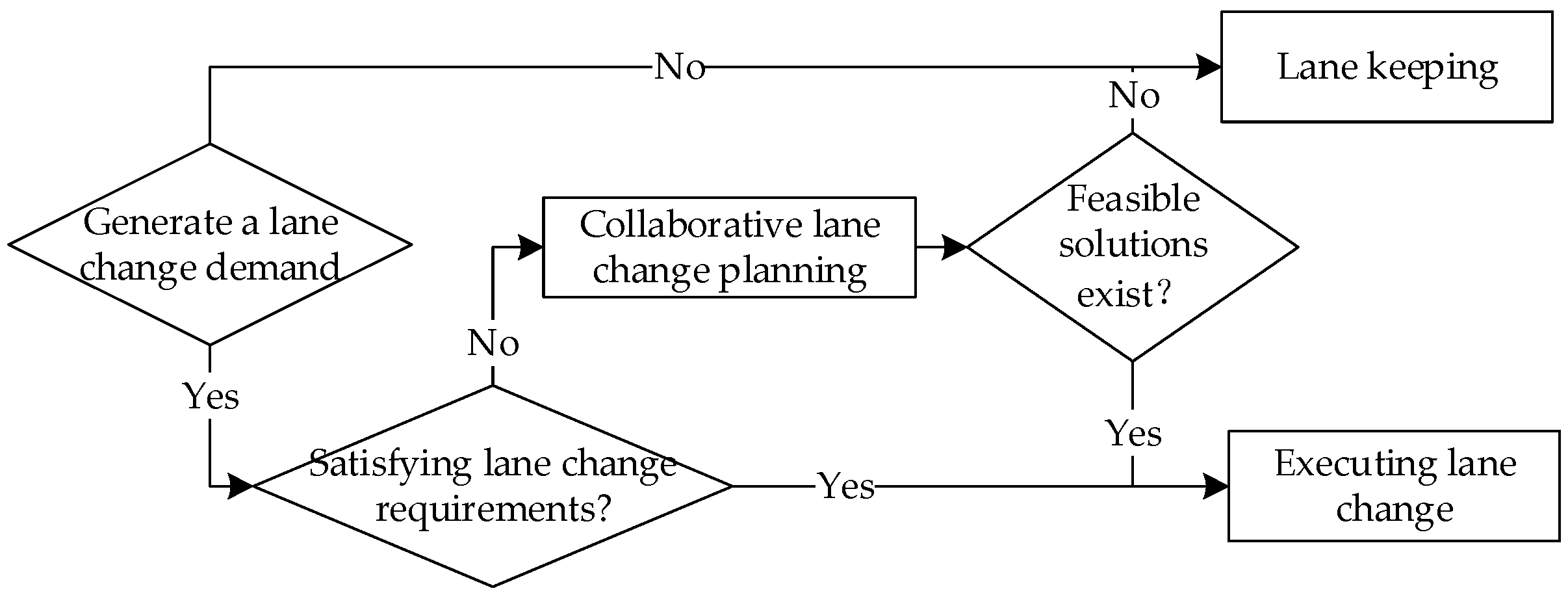

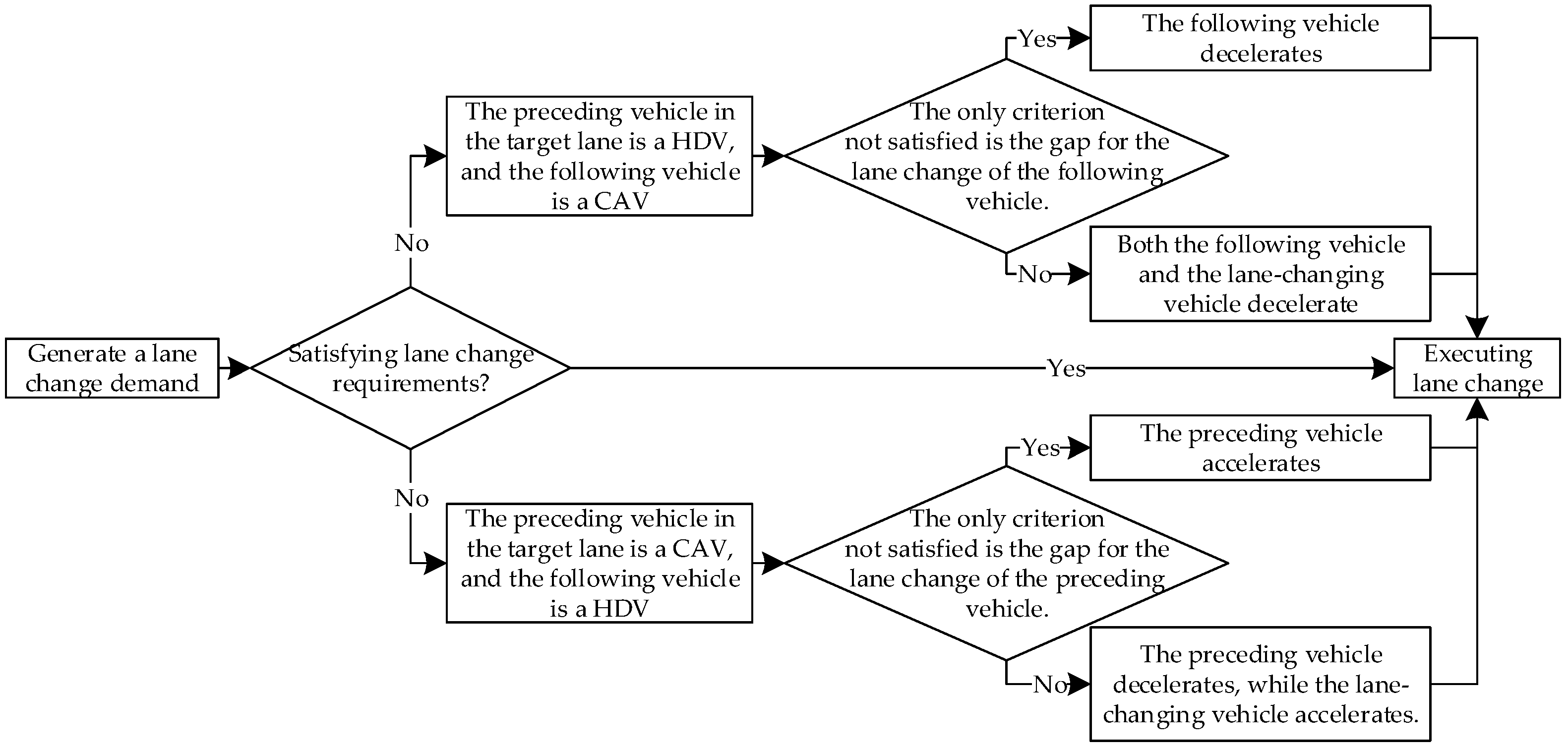





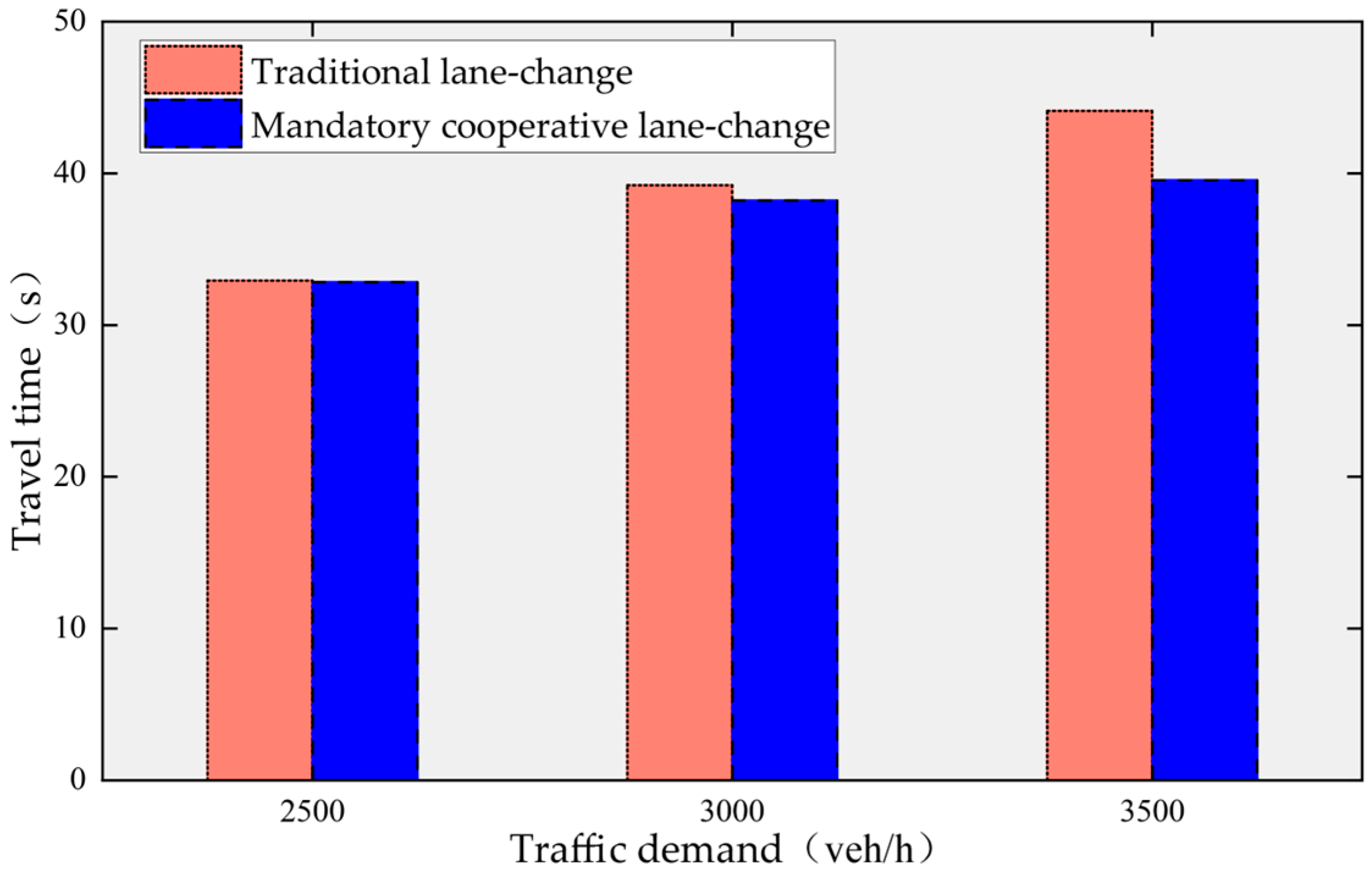
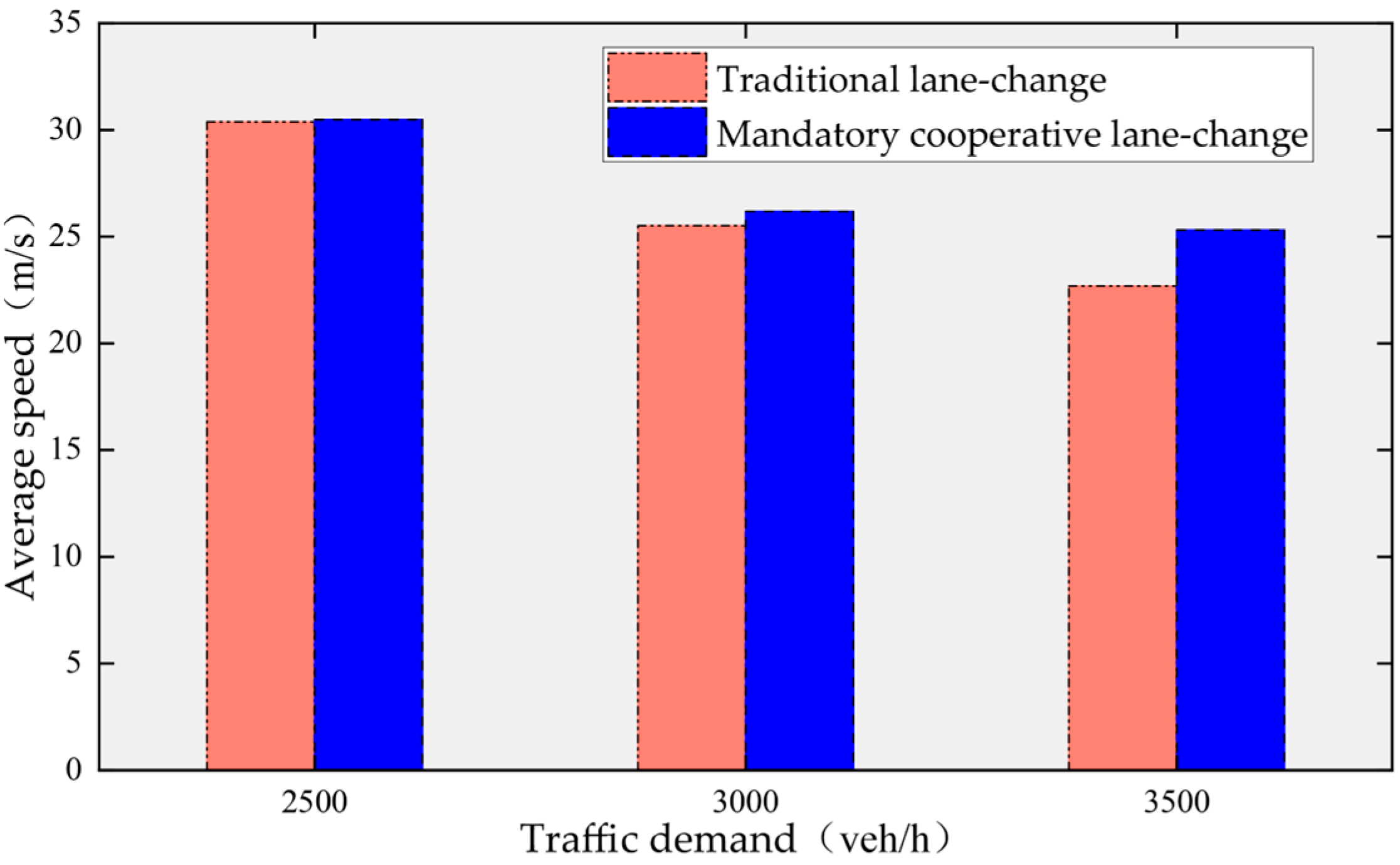
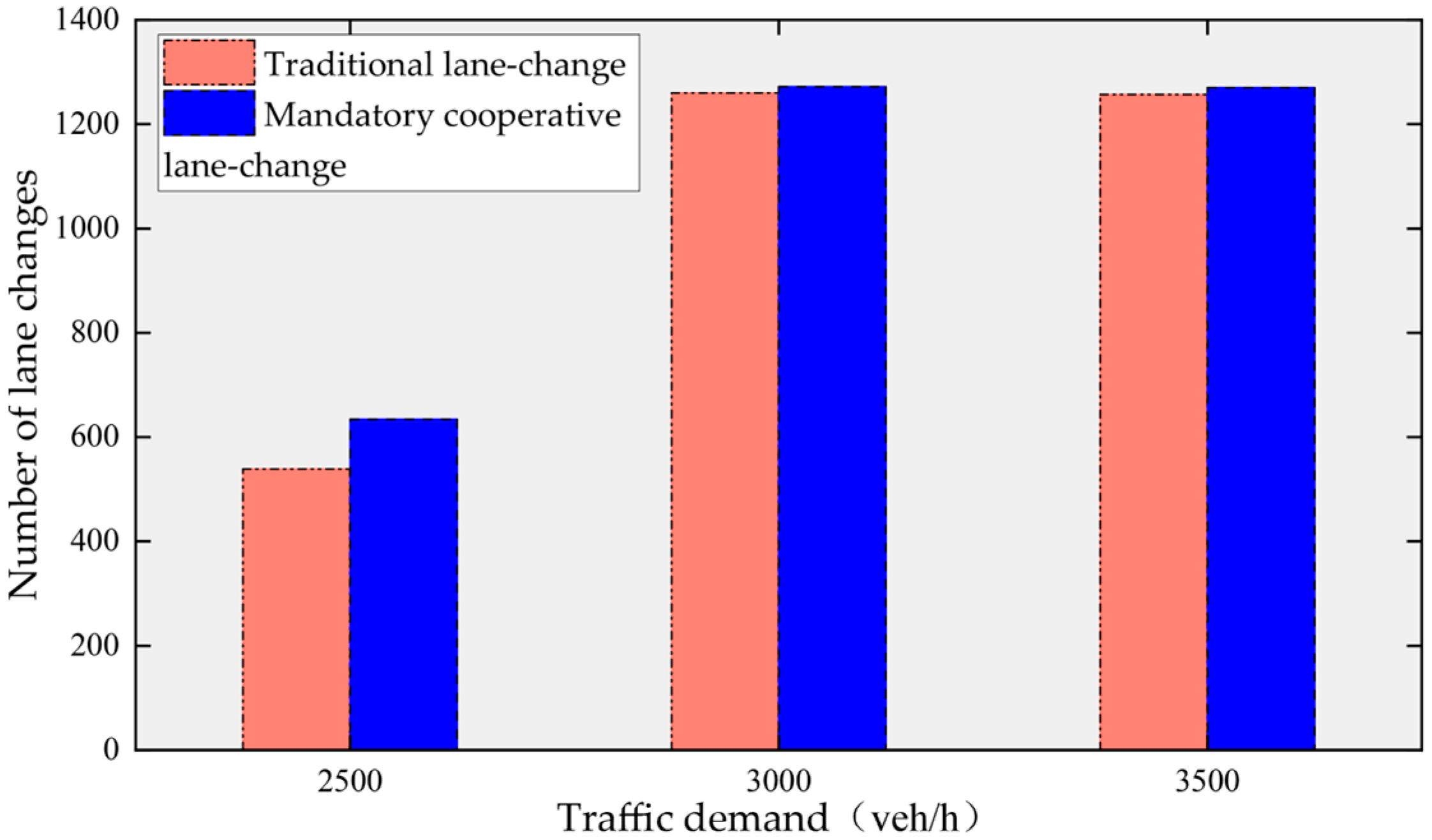
| Parameters | Symbols | Values | Units |
|---|---|---|---|
| Length | L | 5 | m |
| Width | W | 1.8 | m |
| Height | H | 1.5 | m |
| Acceleration | a | 2.6 | m/s2 |
| Deceleration | b | 4.5 | m/s2 |
| Emergency Deceleration | be | 9 | m/s2 |
| Parameters | Symbols | Values | Units |
|---|---|---|---|
| Headway (CAV) | tau | 0.6 | s |
| Headway (HDV) | tau | 1.4 | s |
| Simulation Time Step | - | 0.1 | s |
| Response Time (CAV) | 0.1 | s | |
| Response Time (HDV) | 1 | s | |
| Velocity Deviation (CAV) | speedDev | 0 | - |
| Velocity Deviation (HDV) | speedDev | 0.1 | - |
| Lane-Change Model | Number of Successful Lane Changes | Lane-Change Success Rate |
|---|---|---|
| Traditional Lane-Change Model | 475 | 79.97% |
| Cooperative Lane-Change Model | 524 | 88.22% |
| Parameters | Values |
|---|---|
| Headway between adjacent vehicles in the target lane | 1.3 |
| Initial distance difference between the changing vehicle and the lead vehicle in the target lane | 20% |
| Speed difference between the changing vehicle and the vehicles in the target lane | 1 |
| Traffic Volume (veh/h) | Lane-Change Model | Average Travel Time (s) | Average Speed (m/s) | Throughput (veh) | Number of Lane Changes |
|---|---|---|---|---|---|
| 2500 | Traditional lane-change model | 32.93 | 30.37 | 2500 | 539 |
| Forced cooperative lane-change model | 32.82 | 30.47 | 2500 | 634 | |
| 3000 | Traditional lane-change model | 39.21 | 25.51 | 2954 | 1260 |
| Forced cooperative lane-change model | 38.21 | 26.18 | 2992 | 1272 | |
| 3500 | Traditional lane-change model | 44.11 | 22.68 | 2913 | 1257 |
| Forced cooperative lane-change model | 39.55 | 25.3 | 3016 | 1270 |
Disclaimer/Publisher’s Note: The statements, opinions and data contained in all publications are solely those of the individual author(s) and contributor(s) and not of MDPI and/or the editor(s). MDPI and/or the editor(s) disclaim responsibility for any injury to people or property resulting from any ideas, methods, instructions or products referred to in the content. |
© 2024 by the authors. Licensee MDPI, Basel, Switzerland. This article is an open access article distributed under the terms and conditions of the Creative Commons Attribution (CC BY) license (https://creativecommons.org/licenses/by/4.0/).
Share and Cite
Xiang, J.; Wang, Z.; Mi, Q.; Wen, Q.; Xu, Z. Cooperative Lane-Change Control Method for Freeways Considering Dynamic Intelligent Connected Dedicated Lanes. Electronics 2024, 13, 1625. https://doi.org/10.3390/electronics13091625
Xiang J, Wang Z, Mi Q, Wen Q, Xu Z. Cooperative Lane-Change Control Method for Freeways Considering Dynamic Intelligent Connected Dedicated Lanes. Electronics. 2024; 13(9):1625. https://doi.org/10.3390/electronics13091625
Chicago/Turabian StyleXiang, Jian, Zhengwu Wang, Qi Mi, Qiang Wen, and Zhuye Xu. 2024. "Cooperative Lane-Change Control Method for Freeways Considering Dynamic Intelligent Connected Dedicated Lanes" Electronics 13, no. 9: 1625. https://doi.org/10.3390/electronics13091625






